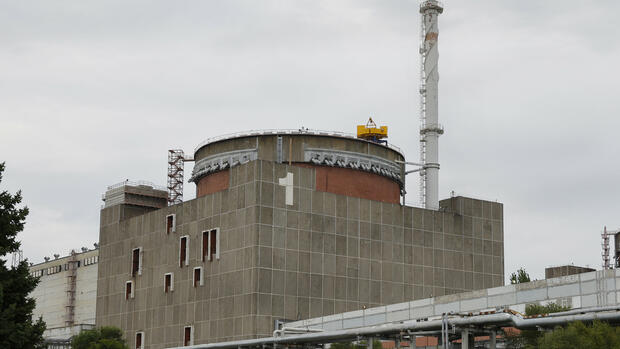Russian troops have controlled the nuclear power plant for more than a year.
(Photo: dpa)
Berlin On Tuesday evening, a warning from the Ukrainian military intelligence service (GUR) startled the world: Russian troops are said to have mined the cooling pool for the reactors of the Zaporizhia nuclear power plant. The six-reactor complex, Europe’s largest nuclear power plant, was occupied shortly after the Russian invasion. “The most frightening thing is that the Zaporizhia nuclear power plant was also mined during this period, namely the cooling pool,” said GUR boss Kyrylo Budanov, without presenting any evidence for this claim. The Russian Defense Ministry does not respond to requests from news agencies.
The report cannot therefore be independently verified. However, the German Federal Office for Radiation Protection (BfS) warns that “everything must be done to ensure the cooling of all safety-relevant systems in nuclear power plants”. Irrespective of a possible mine, the nuclear power plant is threatened by the fighting, repeated power failures and the working conditions of the Ukrainian employees. The Society for Reactor Safety (GRS) also considers the fighting in the vicinity of the plant and the difficult personnel situation to be the greatest risk.
All six reactors at the Zaporizhia power plant have been shut down since September 11, 2022. A BfS spokeswoman said that the risk of a radiological accident is steadily decreasing because the decay heat of the fuel elements is decreasing. Short-lived radioactive substances such as the isotope iodine-131 have also decayed in the meantime. However, the facility still relies on a working power supply for cooling and security systems.
If there were a release of radioactivity, “in the worst case, i.e. only in the event of a significant release of radioactivity and the transport of the contaminated air masses to Germany, values for food specified here in agriculture could also be exceeded”, according to the BfS. Controls of feed and food and any sales bans are possible consequences.
According to the calculations of the BfS, however, “it is not to be expected that further measures such as evacuation, staying in buildings or taking iodine tablets to protect the population in Germany would be necessary”. In Ukraine, however, the consequences could be significant. That depends on the type of accident, the weather and the amount of radioactive material released.
Experts: Cooling at the Zaporizhia nuclear power plant is still essential
Earlier studies by the BfS had shown that over the course of a year, the air masses only moved from the Ukraine to Germany in around 17 percent of the cases. In addition, due to the great distance between Ukraine and Germany, it would take at least one to two days in most weather conditions for radioactively contaminated air to reach Germany. GRS points out that even in the event of a core meltdown, the amount of radioactivity released would “definitely be well below the amounts known from Fukushima or even Chernobyl”.
The head of Ukraine’s military intelligence service claimed that Russia had mined the nuclear power plant’s cooling pool.
(Photo: via REUTERS)
Should the cooling pond actually be blown up, the closed cooling circuit would not be directly affected, as only evaporated water would have to be replaced there. Wells on the nuclear power plant site, a nearby water pit or the water system of the adjacent town of Energodar could also be used for this.
GRS estimates that five of the reactors that have been shut down are currently in a so-called “cold shutdown” with temperatures of 40 to 60 degrees. The reactors are in a subcritical state, meaning that the chain reaction of nuclear fission that runs during operation can no longer sustain itself. The reason: More neutrons disappear from the reactor core than are created by fission processes.
Block 5 is in a “hot shutdown”, also subcritical, but still at a high temperature. In normal operation, the temperature of the coolant is around 322 degrees Celsius, currently it should be around 250 degrees. “Accordingly, less water is needed to cool the reactors,” said a spokesman for GRS. Nevertheless, cooling is still essential.
More: Destroyed dam poses a threat to Europe’s largest nuclear power plant
